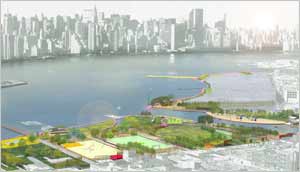2023 PortSide year-end report
/Recap of PortSide’s 2023 impact on public policy, education, and historic preservation! And the year’s not over! There are December milestones and news in here!
Read MoreNYC needs more #piers4boats! PortSide’s blog covers our WaterStories programs, urban waterways issues, the BLUEspace, development plans for the NYC waterfront, our ship MARY A. WHALEN, other historic vessels, and boats and ships of all sizes.
Recap of PortSide’s 2023 impact on public policy, education, and historic preservation! And the year’s not over! There are December milestones and news in here!
Read MoreThe NYC EDC promised Red Hook a lot over the years starting in 2005. The EDC did not fulfill those promises to Red Hook about how their management of Atlantic Basin would benefit the community. Spring 2023, Councilmember Alexa Avilés intervened to fix the latest batch of EDC problems: she ran months of weekly Zooms with the EDC and community members over the summer; she co-authored a City Council bill Intro 1050 that would oblige the EDC to fulfill some of those promises. In response, in September 2023, the EDC put out a press release with yet more promises. Many people are concerned about the EDC’s RFP for Atlantic Basin that they released witthout notifying local people as it looks to be planning a last mile facility, but one using the waterways, and many last mile facilities have been built in Red Hook during the pandemic, with more on the way.
June 6, the EDC shut down PortSide programs while we were trying to get the EDC to renew our berth permit (a contract for our ship MARY WHALEN to be here). We get Councilmember Avilés involved in this too; but the EDC keeps moving the goal posts and the process drags on until October 6, so we lose the whole summer program season.
Our nonprofit PortSide has monitored the EDC’s performance in Atlantic Basin for years (see webpage here) and is one of the victims of EDC unfulfilled promises; so on behalf of all, in late 2022 we launched a campaign to reform the EDC called #rethinkEDC. The EDC is the New York City Economic Development Corporation, a nonprofit, quasi-governmental organization that does a huge amount of work for NYC City government.
The Brooklyn Cruise Terminal (BCT) in Red Hook is located inside the “Atlantic Basin” facility owned by the Port Authority and managed by the NYC EDC. PortSide is in here on Pier 11 aboard the ship MARY A. WHALEN. In 2023, use of BCT on Pier 12 soared to unprecedented levels with many more ships and weekly visits by the biggest ship we’ve ever had here, the 5th largest cruise ship in the world MSC Meraviglia as of April 20, 2023. The max passenger count plus crew count of that ship at 6,636 is about 2/3 of the population of Red Hook. The western side of the peninsula of Red Hook was buried in traffic, causing the B61 bus to be re-routed and an ambulance to drive down the Van Brunt Street sidewalk. Businesses couldn’t get staff and customers in. The gridlock lasted for hours.
How much traffic? What we now know is that standard volume for the MSC ship Meraviglia is 400 to 600 vehicles inbound per hour from 7am until 11:15am, tapering down to 200 vehicles when it ends at noon, according to measurements on 6/4 and 6/11. Red Hook was already agitated about traffic due to number of last mile facilities built here during the pandemic.
Full traffic report here.
* We have two air quality monitors on our MARY WHALEN’s wheelhouse: see Purple air map and our Davis AQI.
Many Red Hook people complained to Brooklyn Borough President Antonio Reynoso and Councilmember Alexa Avilés. Those elected officials wrote a joint letter to the EDC. Alexa sent the EDC another letter on 8/7/23 about shorepower and other cruise EJ issues.
To tackle this, Avilés set up a weekly Zoom call with the EDC, the new Red Hook Business Alliance (we’re members and were on these Zooms), and residents Kiki Rakowsky and Matias Kalwill. These weekly Zooms ran throughout the summer and focused on improving the traffic situation, though other issues lurked in the background:
the cruise terminal had never delivered economic benefits to Red Hook.
the EDC had not fixed the shorepower, though they promised to in 2019 (after years of dodging questions) and getting $750,000 from Borough Hall in April, 2021. The air pollution* is a burden on this EJ neighborhood and does not help fight climate change.
the EDC had not delivered the home they promised to us PortSide on round one (2008 into 2011) or just the building space after the 2018 business plan they made us do. Then, on June 6, 2023 they cancelled our summer programs during an unfair process to renew our berth permit (a contract for our flagship MARY WHALEN to be here). The berth permit negotiations, with CM Alexa Aviles’ office assisting, were not concluded until 10/6/23, so we were prevented from having 2023 summer programs. This may cost PortSide some $30,000 in grant money, deprived us of the opportunity for the many fundraising/friendraising concerts we planned, reduced the number of volunteers we recruited since people often learn about us and volunteer via events; AND deprived those that we serve of our programs.
The EDC released an RFP for Atlantic Basin Anchor subtenant that looked like a plan for another last mile facility – NOT a popular idea in Red Hook - though one using the waterways - and would displace the MARY WHALEN, making PortSide homeless.
During the first of the weekly Zooms with the EDC, Susan Povich, head of the Red Hook Business Alliance and owner of the Red Hook Lobster Pound asked if the EDC had made plans to deal with the huge surge in traffic. The answer was ‘no” and indicative of the extractive way the EDC has run this entire facility (taking the revenue and not givnig back nor mitigating negative effects).
This compounded the nothing the EDC had done over the years to make the cruise terminal easy to find and the Atlantic Basin facility easy to navigate (despite many PortSide suggestions). There was a lack of signage inside and out. They had not communicated directions to all the wayfinding apps the way the Port Authority does for the airports, so hundreds of drivers were misled by uninformed apps. Part of the problem is that the MSC passengers are coming in individual cars, not in coach buses like many of Cunard’s QM2 passengers (a ship that carries half the number of passengers), so the MSC Meraviglia meant many more vehicles and non-professional drivers who might know how to get here.
Chaos ensued, some of it dangerous since pedestrians were not well separated inside Atlantic Basin from moving and parked cars and huge trucks; and the corner of Pioneer Street and Conover was a mess with bikes coming off the Greenway to encounter a gridlock of double-parked cars and clumps of cruise passengers with rolling luggage. The pedestrian gate at that corner is not wide enough to handle more that one person at a time, so pedestrian clustering and clogging was intense.
The vehicular entrance to Atlantic Basin was gridlocked, so passenger pick-up and drop-off began occurring blocks away from BCT, congesting local streets further.
Local users of the Red Hook/Atlantic Basin ferry stop found the ferry system overwhelmed and hard to use. No extra boats were added on cruise ship days.
None of this worked well for anyone.
Avilés and/or her Chief of Staff Ed Cerna ran weekly Zooms, and Red Hook voices shared the latest documentation of problems and offered many solutions. Community people basically tackled a long list of operational challenges that the EDC should know to do and should have done. Here are some early suggestions from PortSide. The EDC was very responsive, and hired traffic engineers who also made suggestions, and things improved each week.
Here are some immediate changes during cruise days:
The interior roadway of Atlantic Basin was changed to 3 lanes, 2 in and 1 out.
The exit for BCT on MSC days became Wolcott Street to get vehicles out faster.
People were paid to direct exiting vehicles as to the best way out of Red Hook.
The MSC ship sailed later to allow for more time for boarding.
The wayfinding apps were all notified of how to get to and into Atlantic Basin. NYPD were stationed at several intersections.
Crossing guards were added to the corner of Pioneer and Conover and the crosswalk just inisde Atlantic Basin by that corner.
The block of Conover south of that corner had the bikepath protected by road cones so that cars could not use it as a loading/unloading zone.
By October, the EDC added ferries on days when cruise ship passengers were visiting NYC, and more.
During the last Zoom of the summer on 8/11/23, the traffic engineers hired by the EDC presented this report (the source of the traffic study slides on this page). The understanding was that the Zoom working group would take a 2-week break and resume to discuss economic development, eg economic benefits for Red Hook – something the EDC had totally failed to deliver to Red Hook in their management of Atlantic Basin, and had not shown any signs of attempting.
Alexa Avilés team did a great job ensuring progress, but a Councilmember should not have to spend this kind of time on operations. This is the kind of work a good economic development agency would do on their own.
During the first month of weekly EDC Zoom meetings, Avilés had also been partnering with the Councilmember Erik Bottcher, who has the larger Manhattan cruise terminal in his district, to co-author City Council bill Intro 1050, released May 25, 2023, which would oblige the EDC to do what it has not done on its own. The bill mandates that the EDC supply shorepower at both terminals, only allow ships that use shorepower to visit NYC, and create traffic management plans.
Avilés and Bottcher held a press conference about Intro 1050 on Red Hook’s Pioneer Street on September 18 with a cruise ship in the background.
Councilmember Alexa Avilés
Brooklyn Borough President Antonio Reynoso
NYS Senator Andrew Gounardes
Ten days after the press conference about Intro 1050, on September 28, 2023, the EDC surprised everyone by putting out a press release with promises about shorepower use, traffic plans, and community benefits. The relevant Councilmembers Bottcher and Avilés were not quoted (a deviation from protocol), nor were any Red Hook voices. The EDC has a history of NOT fulfilling promises in Red Hook, so having the EDC promise more things has not been reassuring.
Additionally, the terms in the EDC proposal leave much to be desired. Here are some observations:
The EDC proposed their own (slow) schedule for installing shorepower, did not separate the BCT shorepower timeline from Manhattan (fix ours already, Manhattan doesn’t have any yet, so why should Red Hook have to wait until Manhattan’s is installed?).
The EDC is offering to create a community benefit fund via a head tax on cruise passengers, but that is not fair to Red Hook. This neighborhood gets no significant economic benefit from the cruise ships whereas Manhattan does, and the EDC makes money here via more than the cruise terminal. In short, Red Hook deserves a share from ALL that the EDC makes in Atlantic Basin and should get a higher percentage than Manhattan since Red Hook gets almost no indirect economic benefits from the cruise terminal but Manhattan gets lots.
Also, the EDC proposes to manage the community benefit fund, but why would Red Hook trust the EDC to run the community benefit fund they are proposing? They’ve ignored the community for years.
The EDC should fulfill some old promises, one being space for a fully-realized PortSide NewYork, NOT displacing us via an RFP.
At some point in the year, the EDC began to backtrack on one improvement, their new BCT schedule webpage. In 2023, they FINALLY separated Brooklyn and Manhattan cruise shedules onto separate webpages (something PortSide suggested for years) and grew it to include all we had suggested. The backtracking shows how the EDC evades accountability and transparency. The colums on the right side of the page have changed. At the point we think they were the best, they showed if a ship was shorepower compatible and if it had connected to shorepower.
It’s no longer possible to tell if a ship connected. As of November 5, 2023, and for some time now, the two right columns say if the ship is shorepower compatible and if it is BCT shorepower compatible; there’s no info about actual connection.
At some point, the EDC also began deleting the list of ships that had already been here this year, so it’s not possible to see at a glance how often cruise ships are impacting Red Hook in terms of ship exhaust or vehicle traffic.
Similarly, the EDC’s new language about the Brooklyn shorepower evades accountability. This year the EDC began saying “we are proud of the Brooklyn shorepower installation for being the first on the east coast.” That positioning is slippery PR and severely disrespectful to the EJ community of Red Hook that fought to have the shorepower installed and then suffered years of EDC evasion about why it isn’t working and years of EDC delays fixing it.
For a detailed history of the BCT shorepower saga, visit Adam Armstrong’s blog (active into 2018) and very active Twitter feed.
PortSide’s experience renewing our berth permit in 2023 reveals the kind of EDC machinations that are chronic.
Starting Spring 2022, the EDC would deny PortSide requests saying “it violates our lease with the Port Authority.” We’d check with the Port Authority; and in every case, the EDC statement was false. For example, no, the EDC is not prevented from renting us the size building space for the term we requested in our 2018 business plan.
After checking with the Port Authority several times about such EDC claims, the Port Authority told us to FOIL the lease (submit a Freedom of Information Law request, the official way to get info from governmental organizations). We did that immediately in October 2022.
During our berth permit negotiations, in April 2023, the EDC claimed another PortSide request violated their lease, our desire to again have a shipkeeper (overnight presence on the ship). Unfortunately, the Port Authority didn’t respond for almost two months, so the EDC said our summer programs were cancelled since we hadn’t signed the berth permit while were waiting to hear from the Port Authority. The Port Authority responded promptly to the cancellation of PortSide’s summer programs by sending their lease with the EDC (and no, shipkeepers are NOT prohibited) and by sending a Port Authority shipkeeper policy (which the EDC ultimately ignored).
We got our Councilmember Alexa Avilés involved and asked for her to run Zoom meetings with the EDC as she had done for the cruise traffic issues above. We are certain that her presence and pressure helped, but the EDC kept up the machinations. Next, the EDC said we needed more insurance. We got more. Then, they said we needed even more insurance, and we got more.
Then, the EDC claimed our insurance didn’t cover liquor use; but we clarified that it did. This dragged on until Friday 10/6/23, so we lost a whole season of summer programs, which may cost us grant money.
In the end, the EDC ended up deleting the reference to the new Port Authority shipkeeper policy we put in our draft of the berth permit, so the position of their landlord was only relevant when the EDC was misrepresenting it to deny PortSide something. If the Port Authority position didn’t support the EDC’s position, then the EDC ignored it.
As we say, time to #rethinkEDC for a better PortSide, a better Red Hook, and a better NYC.
2016 year in photos at PortSide NewYork!
Read MoreOn the occasion of the 4th anniversary of Sandy, PortSide NewYork launches Red Hook WaterStories. This is a digital museum with significant resiliency information. The site covers 400+ years of Red Hook waterfront history - NYC’s maritime story in microcosm - and reveals forgotten and overlooked stories from this evocative neighborhood.
Read MoreREBUILD BY DESIGN PLAN BY HR&A COOPERS ROBERTSON PUTS PARK SPACE ON TOP OF THEIR PROPOSED PROTECTIVE SEAWALL.
By Carolina Salguero
This blogpost is a response to Curbed’s 1/28/16 article about Red Hook which carried only parts of several long conversations with Nathan Kensinger. Here is more of what I said so that my position, and PortSide NewYork’s, on changing Red Hook is better rendered.
The Curbed article looks back; my waterfront work, from my photojournalism to founding the forward-looking non-profit PortSide, focuses on the growing maritime sector, making change and shaping the future. At PortSide, we use history to further Red Hook's development. All images, except the rendering above, are copyright Carolina Salguero.
Red Hook has evolved from a place perceived by 1990’s national media as a hopeless crack den to a peninsula that in 2014 was the announced recipient of a "first in the nation" plan for urban flood protection.. Hello IFPS! That is our future, example to the nation.
I understood Est4te Four to be the core of Nathan’s intended story. Thus, I said that, given that Red Hook was going to change, hugely change, it was better that we have Est4te Four, with a curated vision and their standards, than have the building boom of “luxury”’ housing such as occurred on Fourth Avenue in Park Slope/Gowanus. That left us with a hodgepodge of dreadful buildings like the yellow brick one looming over the historic Old Stone House.
Yes, we talked nostalgia. We talked a lot about Red Hook changes and my personal markers for the stages of evolution.
This led me to remark that we all seem to fall in love with the Red Hook of our first contact, and the point of that remark was not to say that my first experience of 1997 (as a visitor, I moved here in 1999) was better or more valid than that of someone arriving in 2002 or the 1980s, but to convey how Red Hook triggers a deep love that is very nostalgia based.
All newcomers to Red Hook love Red Hook, that’s why they come (you don’t come here for the great transportation), and their love starts in, and connects to, the era they arrive.
I said that was one of the great things about my being involved with Red Hook, it has an engaged community that cares about this place.
My view of Red Hook is so NOT nostalgia-driven that I had a lot positive to say about IKEA. IKEA’s Sandy recovery work (done with Swedish modesty that did not tout what they did) was so significant that PortSide honored them for it.
I said the IKEA waterfront esplanade was very well designed, one of the best in the city. I said all that despite saying that closing the graving dock was a policy mistake by the city and a personal loss to me; it was my photographic muse for 5 years. I had unfettered, permitted access to it and could come by land or sea, day or night; and I had the run of the old shipyard too.
The Curbed piece concludes with the quote “"It's not going to be the same Red Hook for a lot of the people who live here now."”’ whereas I talked quite a bit about the people who are likely to stay in Red Hook, the overwhelming majority of Red Hook’s residents, eg the residents of the NYCHA development in the Red Hook Houses East and Red Hook Houses West. I said that for all the problems faced by those folks, they had a large measure of residential stability.
I said that one of my hopes for Red Hook was that, with all the change, wealth and resources coming to the Red Hook around the Houses, more resources would be focused on helping those NYCHA residents. Some of that was visible in the great number of homegrown non-profits on this small peninsula. I said that entrenched, urban poverty was a tough challenge, but that we should try. It is certainly part of PortSide’s mission.
I said that even with all the new people moving in, much stayed the same: Red Hook the close knit community where gossip and rumor are big. Gary Baum, the friend of the pick-up truck sledding mentioned by Nathan, used to joke that if you sneezed, in 10 minutes people know that 7 blocks away.
All of which led me to remark that what I wish Red Hook would get better at research and negotiation since so many of our land use issues were characterized by “did you hear that?!!” shock that was not necessarily based on fact; and that, as a community, we had yet to negotiate benefits from any major real estate development. Segue to NY Rising, a change in that dynamic.
Once Nathan and I got off the nostalgia beat, I spent a lot of time talking about NY Rising, my voice starting to crack with emotion when I talked about how beautiful it was for me to see that the disaster of Sandy had germinated something that augured such good for Red Hook.
NY Rising is a NYS program, and its Red Hook committee members (including me) were appointed by the State to craft a resiliency plan for $3MM in funds the state would provide.
It was a helluva lot of work over some 9 months, but we had the benefits of the region’s best consultants, paid by the state, to support the effort. I said it was a new model worth remembering: government paid to give grassroots community members planning resources (as opposed to Community Boards in gentrifying areas that are overwhelmed by trying to respond to Land Use permits and variances and that are not funded in proportion to that workload. Hint, hint, NYC.)
Official NYS webpage for NY Rising statewide
Official NYS webpage for NY Rising Red Hook committee
Blog of Red Hook’s NY Rising committee
Final resiliency plan of NY Rising Red Hook committee, shorter executive summary and mini brochure version.
Red Hook's NY Rising committee has gone well beyond the State-appointed mission. We proposed programs exceeding that budget. The committee has already sought and secured outside funding to further some projects, including the microgrid. The committee has continued to meet and is becoming a non-profit to further work in Red Hook. It is also looking to expand members. GET INVOLVED! It sought the support of the Municipal Art Society to host the Red Hook Summit about resiliency projects in Red Hook.
COME TO THE RED HOOK SUMMIT! It is Saturday, 1/30/16, 10am – 1pm at Summit Academy, 27 Huntington Street. Full disclosure, I am presenting for PortSide there.
I talked to Nathan about my role on NY Rising where I tried to raise NYCHA issues (I proposed the solar-powered emergency lights in the final plan) and my big focus was activation of the waterfront (the waterways, really) and ensuring that the wisdom of NYC’s 2011 waterfront plan Vision 2020 (embrace and activate the waterways!) was not drowned by Sandy (water is destructive, let’s build walls!).
As a result, I was very moved when at the IFPS (Integrated Flood Protection Study) meeting last week, community members very strongly supported the idea of waterfront access and maritime activation that were on the sheet of NY Rising “values” had the room discuss.
Listening to the IFPS room, with the report-back from each break-out table echoing PortSide values for the waterfront, I felt that I, and PortSide staff and interns, had really made a difference preparing advocacy papers, blogposts, webpages, walk-to-ferry-landings studies, etc for NY Rising, all of which is shared on our website. Our NY Rising work and waterfront vision was embraced by the room without our having spoken up for it in that room. Given that the IFPS is a “first in the nation” program, the eyes of the world are on us in Red Hook, so it was powerful for me to see PortSide’s harbor advocacy work picked up by the IFPS process.
The thrust of Nathan’s Curbed piece is displacement, new replacing the old, but I also talked about what NYC’s real estate driven press (Ahoy, Curbed!) does not cover very much: the growth of the maritime sector. So I rattled off some Red Hook increases in maritime activity since I moved here in 1999: New York Water Taxi (a new company, and headquartered in Red Hook), Vane Brothers tug and barge company expanding two times beyond the footprint of the old Ira S. Bushey yard at the foot of Court Street (where the MARY A. WHALEN started work in 1938) to GBX and Port Authority piers, a new cruise terminal, and Red Hook Container Terminal expanded business (despite hiccups of lawsuits, Sandy and more), and the founding of PortSide NewYork, to create a maritime hub that would foster the community revitalization of Red Hook along a water and maritime theme, combine working waterfront, public access and community development and be a test lab and advocate for expand that model harborwide.
I told Nathan that in September, 2015, PortSide asked the EDC for the space inside the Pier 11 warehouse next to the ship that had been promised to us in 2009, 2010, and 2011 – space that the EDC had also promised to the community as the home for PortSide.
I concluded by sending Nathan two renderings of what PortSide plans for Pier 11, a forward-looking vision for Red Hook. Here is what we are working towards! #GetOnBoard and join us!
2015 was a year of major milestones and growth. See, read and feel it below.
The pivot point was the exhilarating move on May 29 in the video at right.
Our new site strengthens our ability to fulfill the PortSide vision of combining the working waterfront, public access and community development.
Please donate now and support our momentum!
The public access at our new home enables us to grow our educational programs. We hopped on it right away with outreach such as our Open House for Educators Week and researching new curricula. We gained new partners in the World Monuments Fund, the Williamsburgh HS of Architecture and Design (WHSAD), and Behind the Book. We had three summer interns from WHSAD and two college interns from Spain. We created a curriculum for simple machines aboard the MARY A. WHALEN and taught Hurricane Sandy & resiliency to elementary school kids. For adult job training, we furthered our relationship with the painters' union District Council 9.
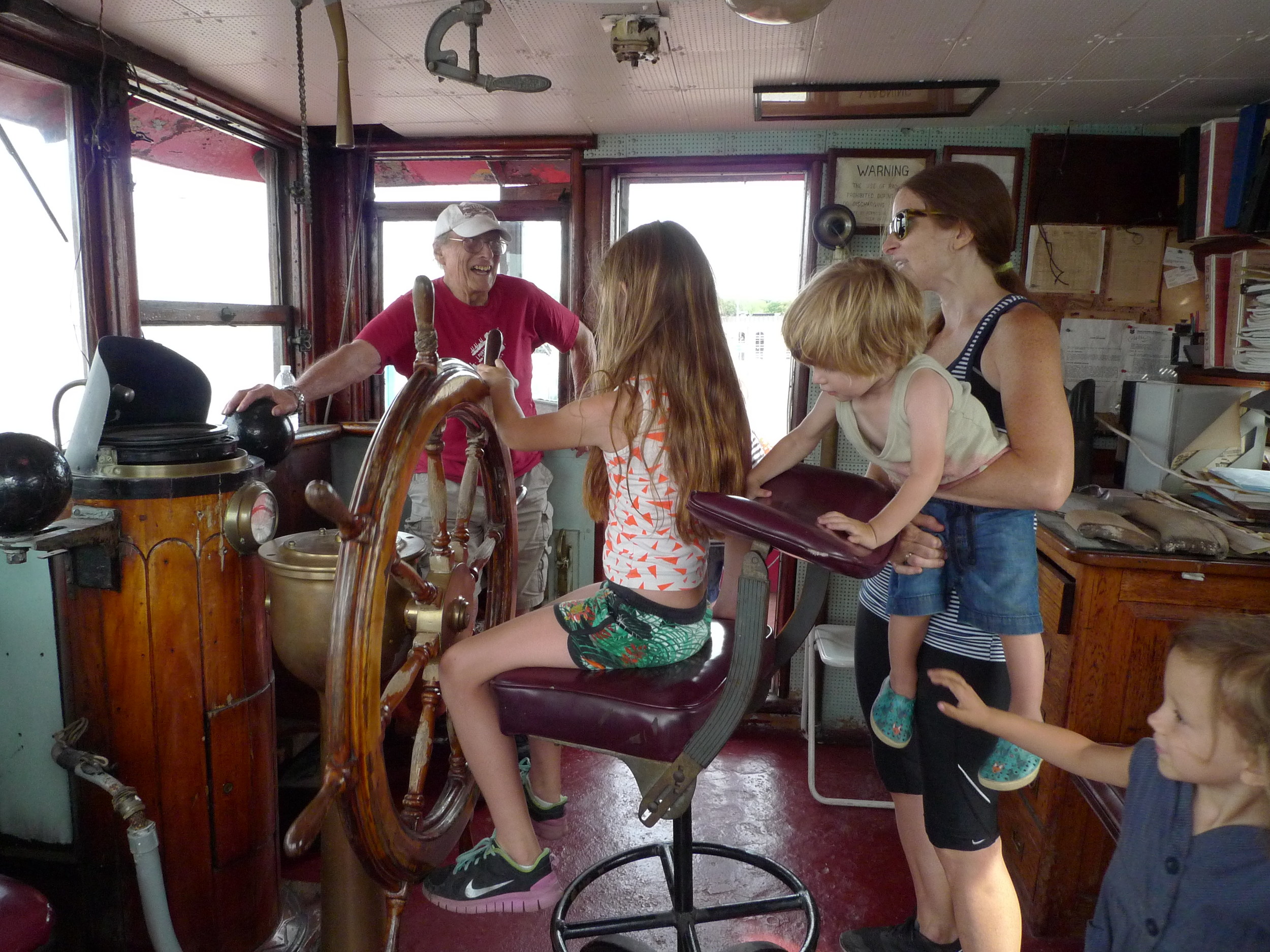
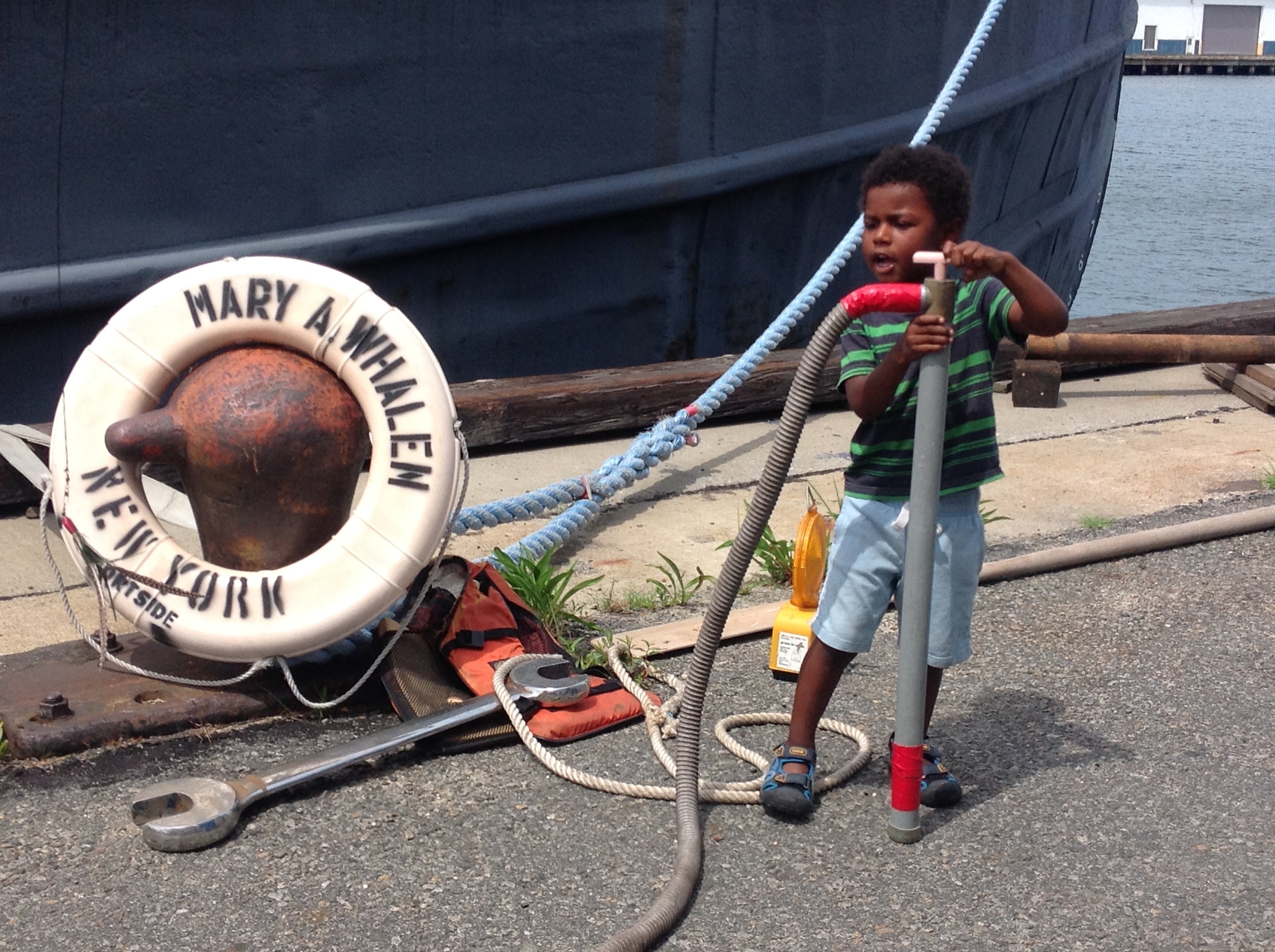
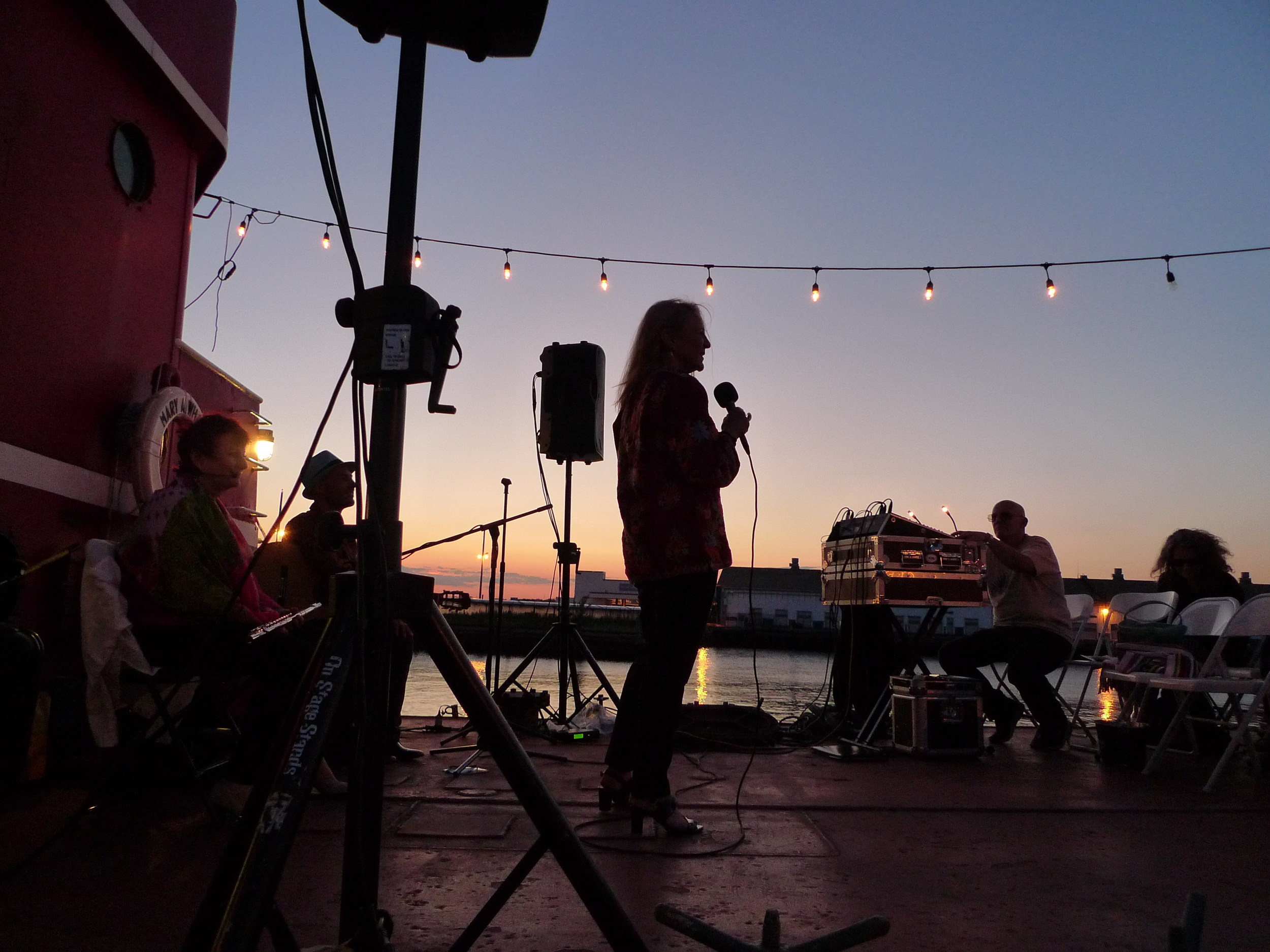
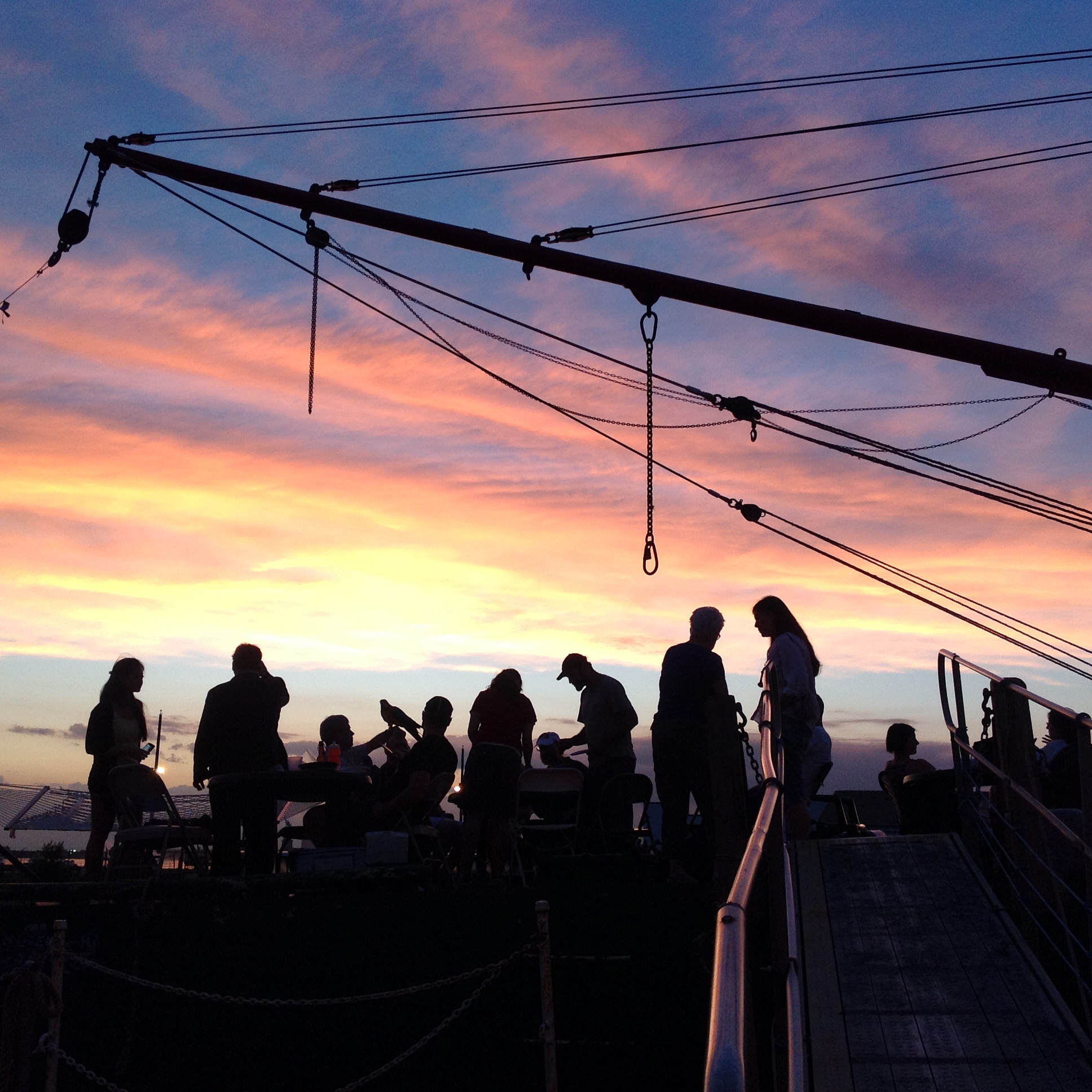
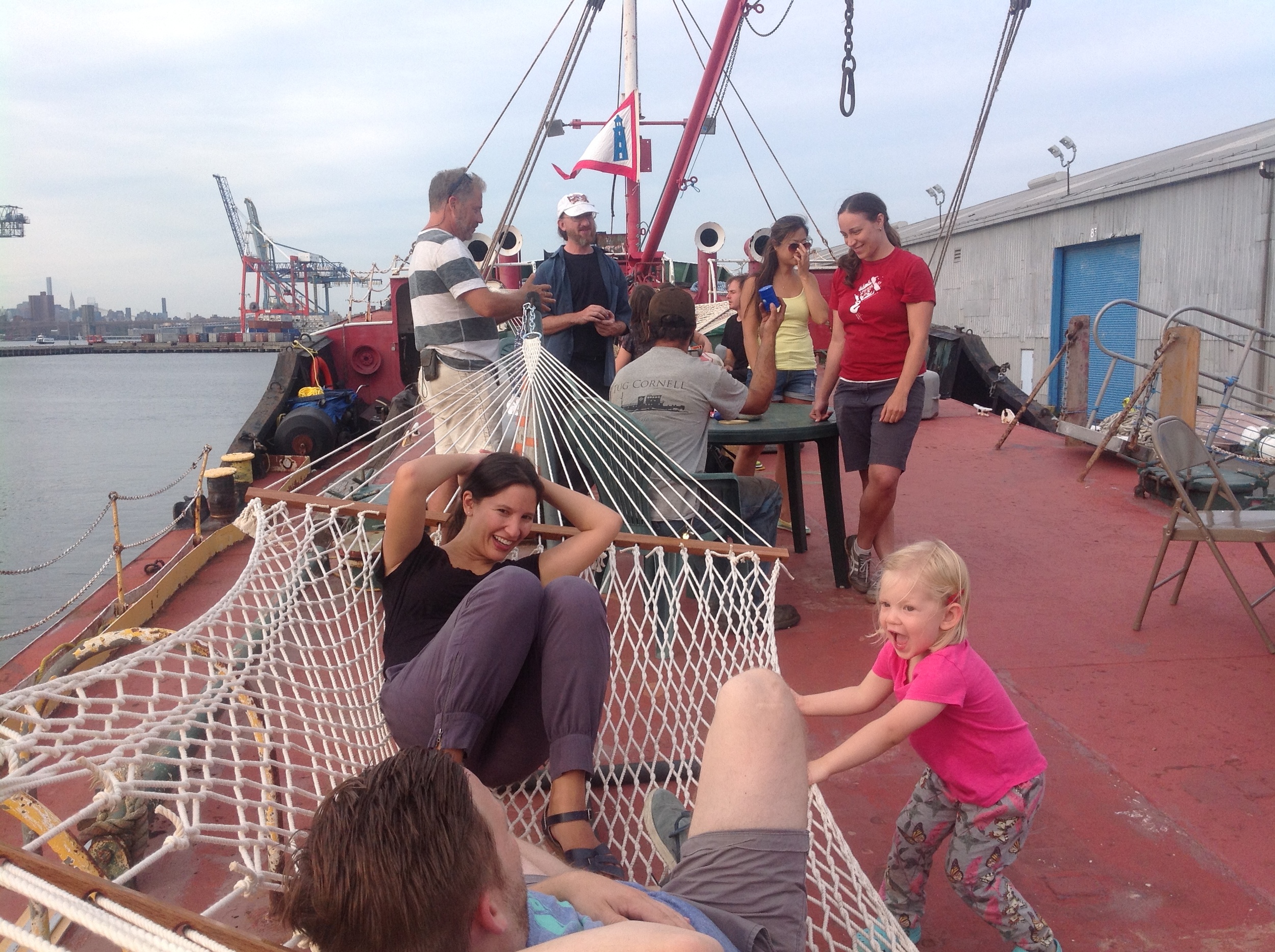
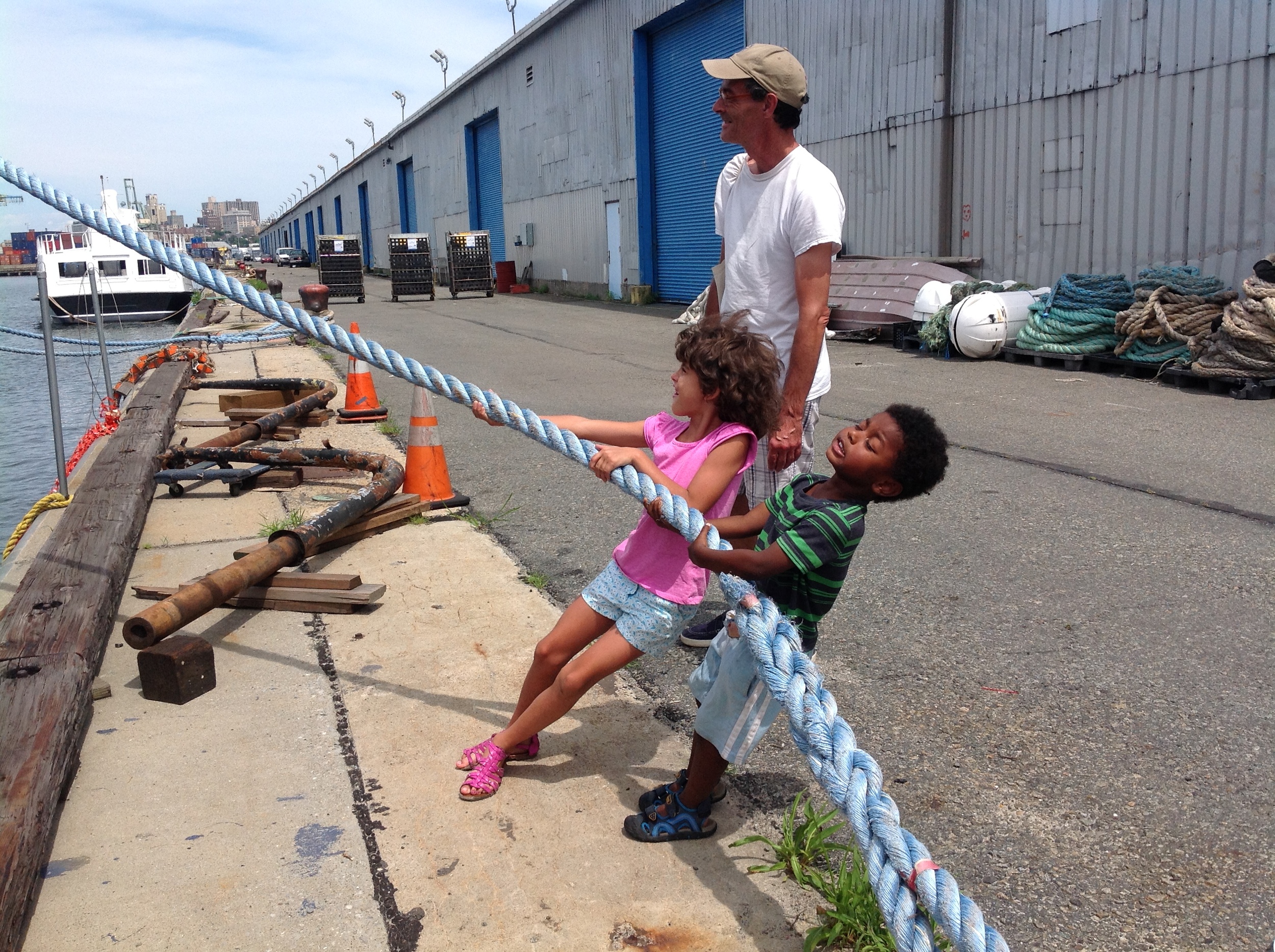
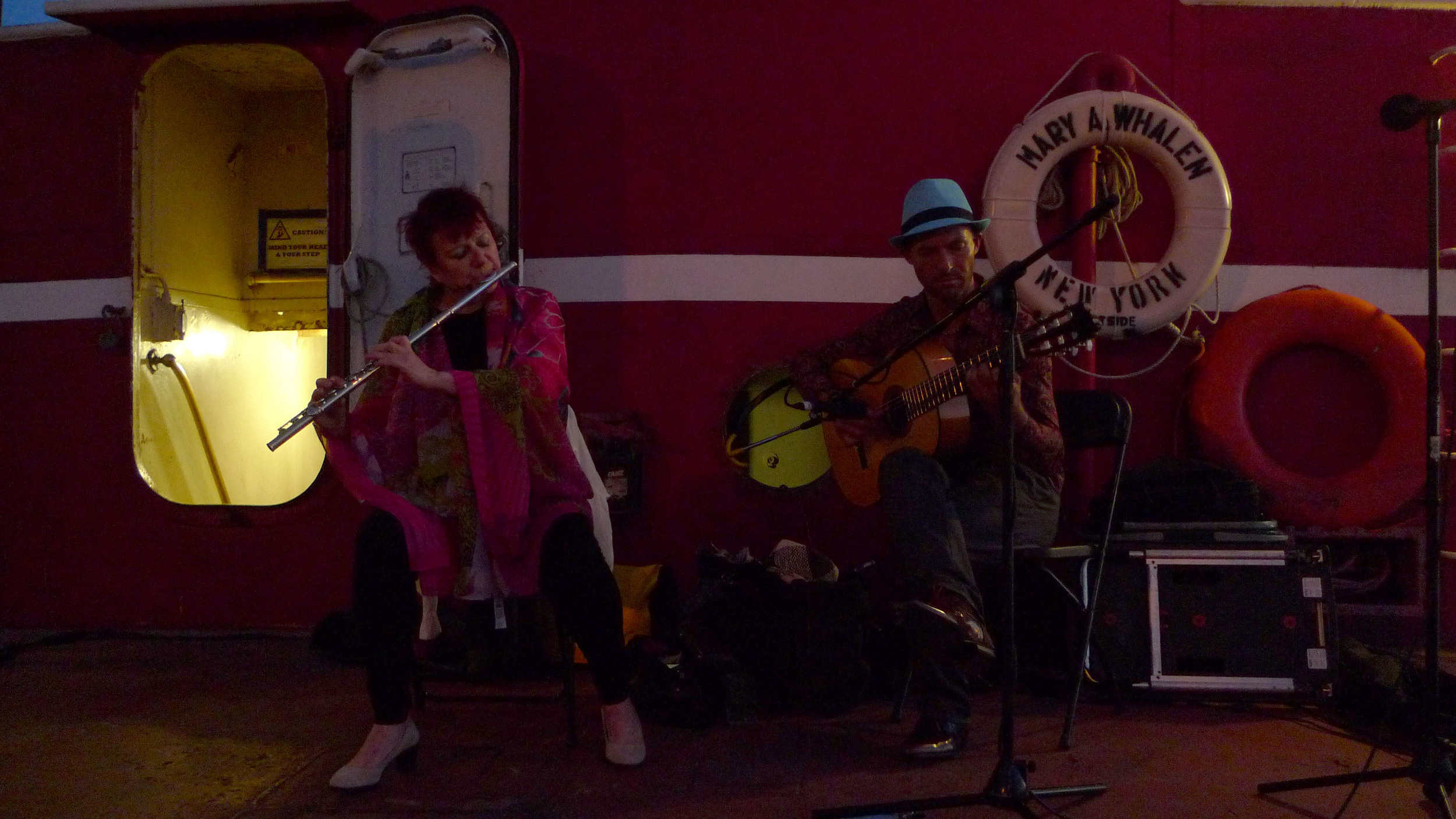
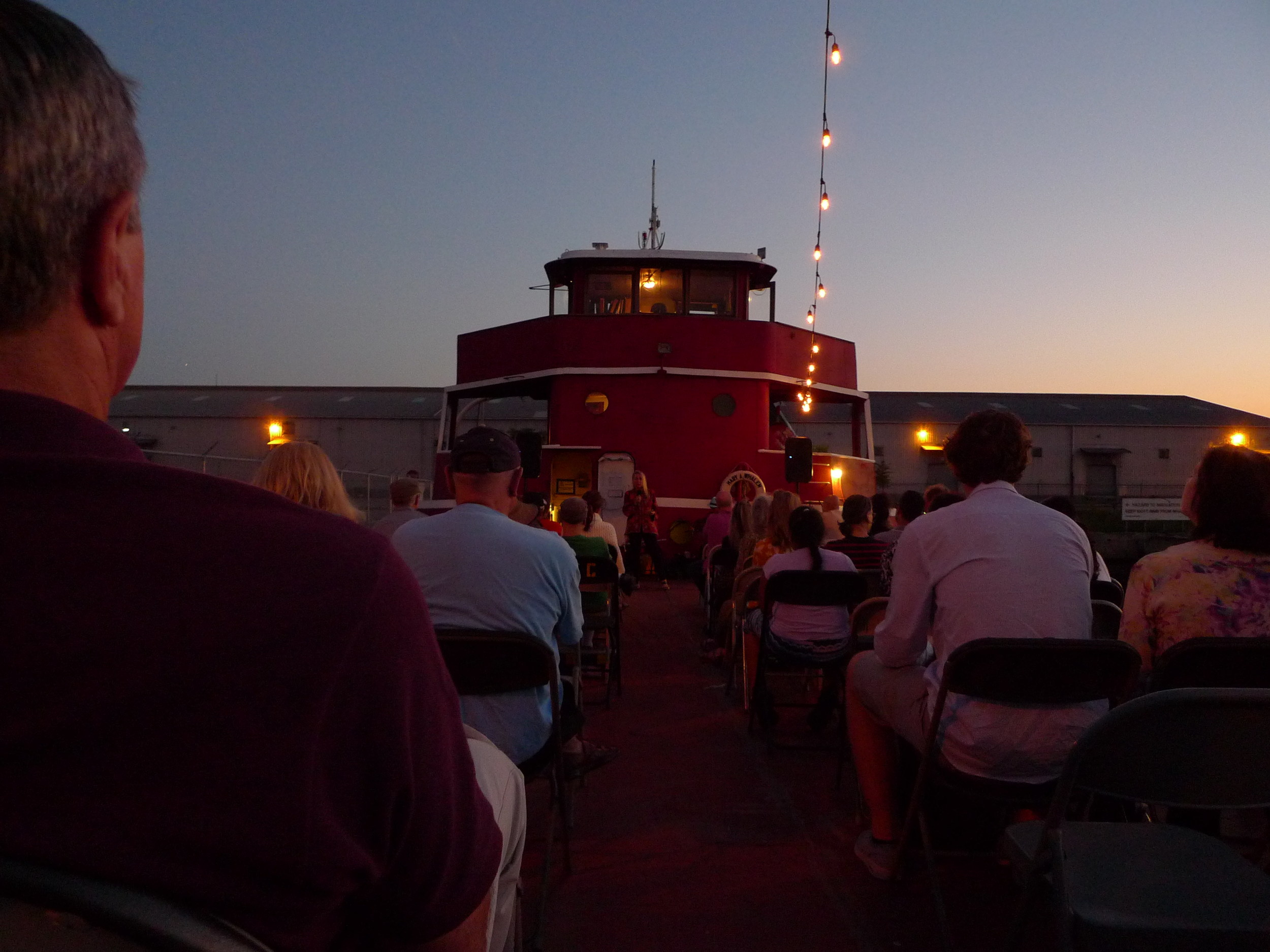
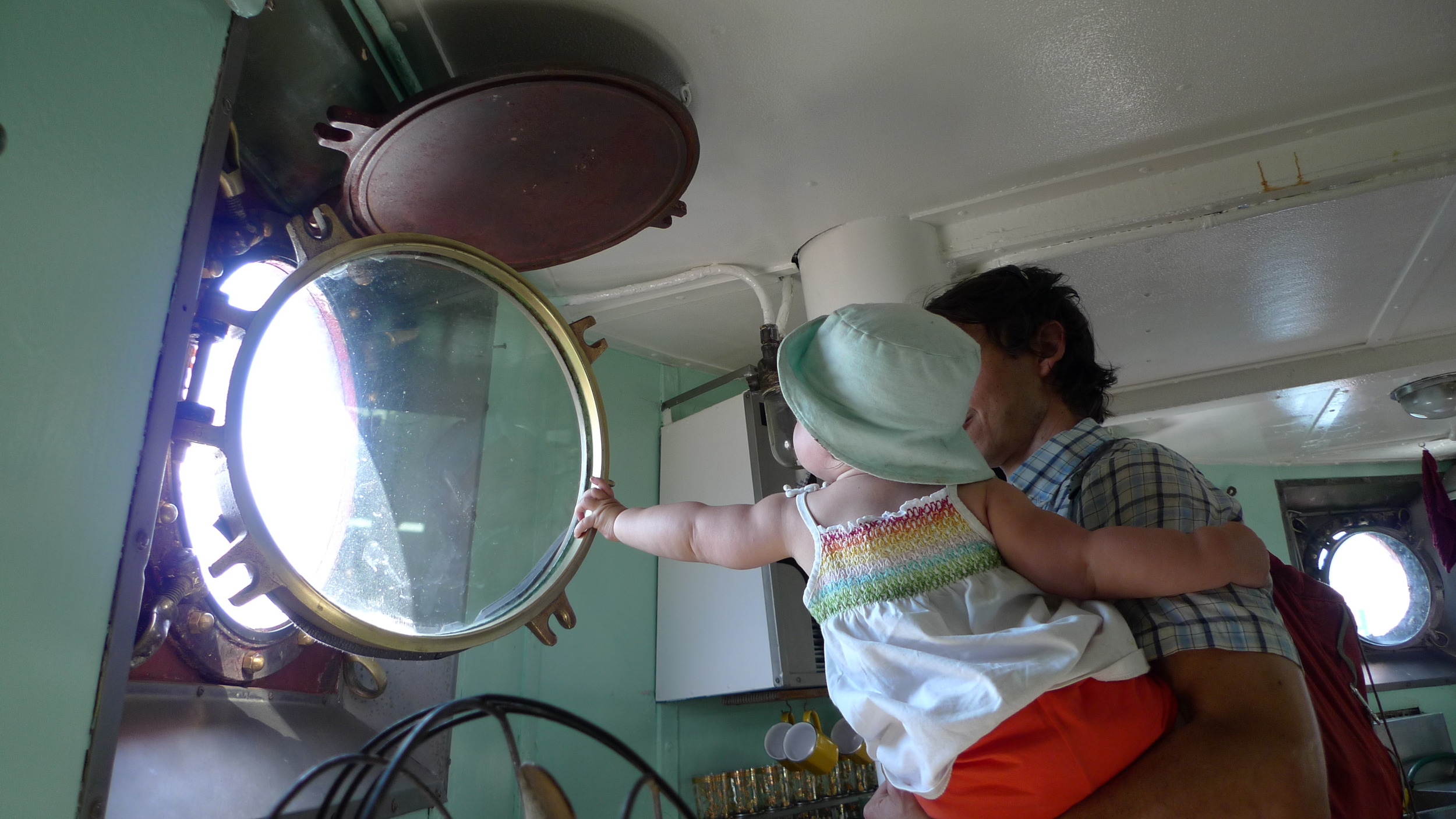
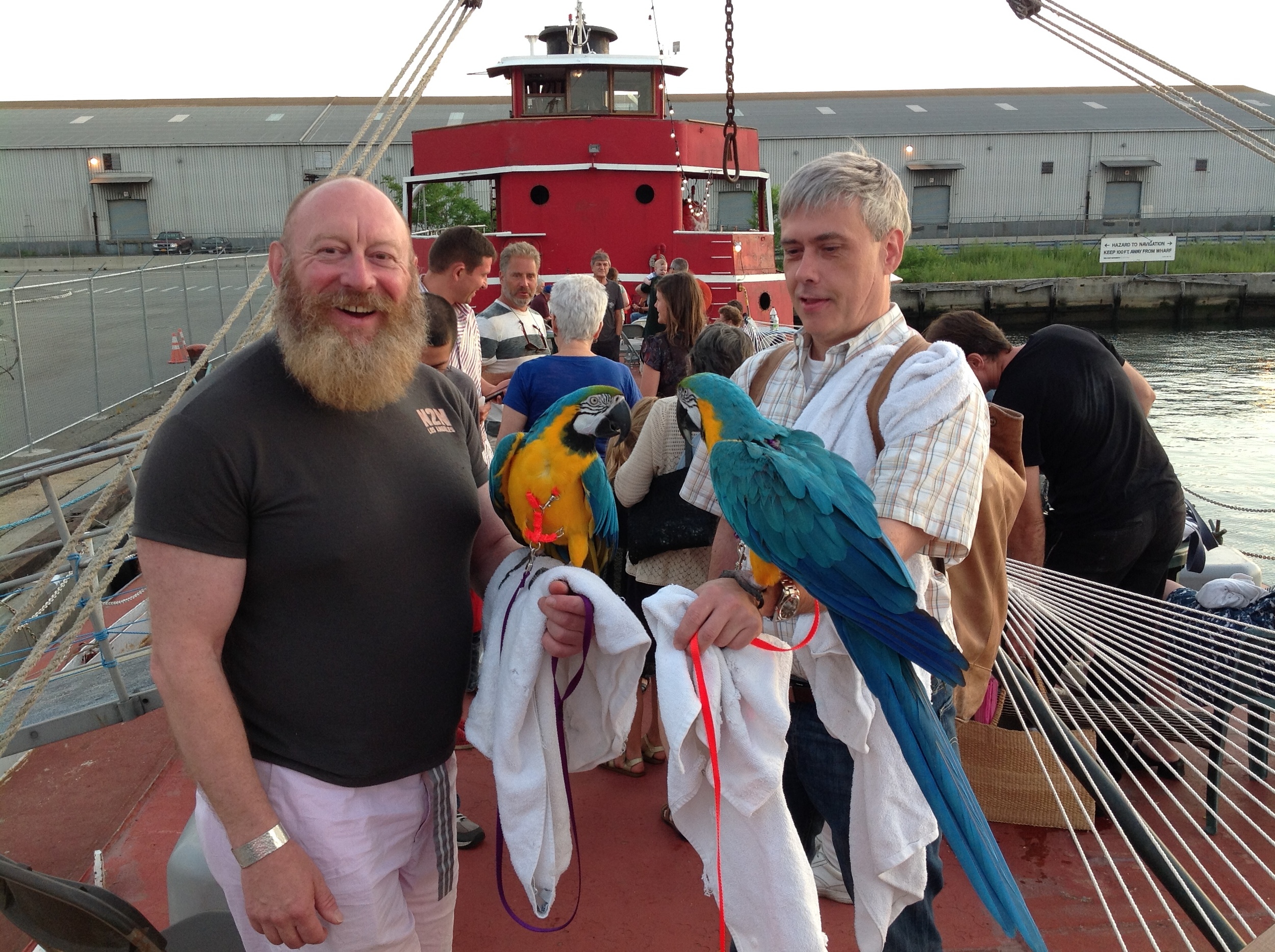

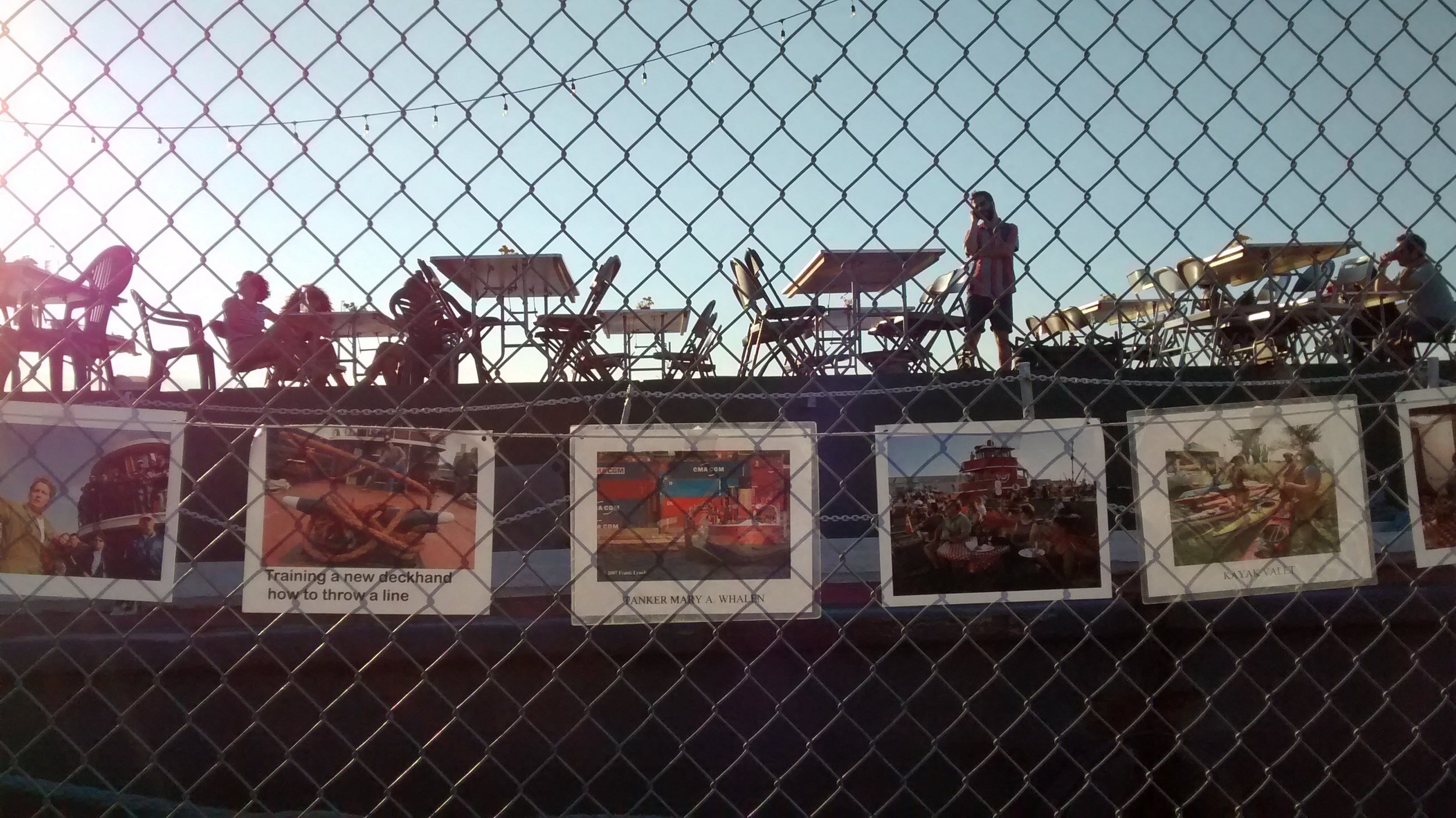
We secured $20,000 in funding from Councilman Carlos Menchaca to support our Red Hook WaterStories cultural tourism, placemaking and resiliency project. We were invited to join a historic ship flotilla that celebrated Cunard's 175th anniversary and got community members in the parade via our partner, the historic tug CORNELL. We curated and ran a great POW! weekend with TankerTours, TankerTime and gifted flamenco jazz musicians who have offered to make this an annual event. We produced a distinctive multimedia history night with Norwegian Red Hook WaterStories with bluegrass musicians from Norway, history speakers, and vintage video. Out shipcat Chiclet has become an attraction, with a growing fan club of regulars who come by to see her.
Volunteers repainted three cabins! Thank you, volunteers! Three summer interns from WHSAD did enormous work restoring the teak rail around the wheelhouse. The painters' union District Council 9 will repaint the exterior as a training excercise with paint donated by International Paint. DC9 scoped out the job, did some prep work, and laid plans for painting in 2016.
History runs through so many of our programs: all events on the ship, programs such as our Norwegian Red Hook WaterStories night, info content we share on our Facebook and Twitter, our blogposts such the one about the important sale of slave ERIE ship in Atlantic Basin which marked an important step in the end of slavery in the USA. In 2015, we added considerably to Mary A. Whalen history: more former crew members found us (thanks to our new home): Engineer Bill Siebert who works on a Vane tug and retired, 86-year old, former relief captain Thomas J. Smith. Captain Smith donated his maritime papers to us, and we have taped hours of interviews with him. A big boost in the history department was the visit by Scott Gellatly and his wife Pat. They ran a waterborne fuel transportation company years ago and almost bought the MARY. The Gellatlys donated photos, recorded hours of interview and brought along retired engineer Bryan Sinram, another trove of history, who had worked for Eklof, the company that ran the MARY WHALEN for years. Walter Barschow donated the folk painting of the MARY aground in the slide show above and gave us leads on Red Hook WaterStories about his family that ran a scrap yard for decades, founded by his German immigrant grandmother. Karen Dyrland and John Weaver donated another large cache of photos, letters and documents from Alf Dyrland, Captain of the MARY from 1962-1978. And, our home, the historic tanker MARY A. WHALEN turned 77!
PortSide continued to inspire filmmakers, painters and multi-media artists. Most find us because they can now see us. The MARY A. WHALEN is visible from our new friends and partners Pioneer Works which leads to a steady stream of artists coming to brainstorm, photograph, get ideas, one even collects salt water for a printing project. We gave the title to the documentary film BLUESPACE and appeared in it. We invited painter Jim Ebersole to memorialize our final week in the Red Hook Containerport.
This important work does not generate inspiring, cuddly or sexy photos. It involves a slew of emails and hundreds of conversations that advance our vision for bringing change to NYC's waterfront. Some highlights: Our President Carolina Salguero was appointed to the Sunset Park Task Force whose first task was to advise the EDC on creating an RFP for SBMT. How's that for alphabet soup! The Task Force continues to meet to shape the Sunset Park waterfront and industrial waterfront district. PortSide provided info and advice on the siting of a Citywide ferry stop in Red Hook. We are engaged with the ongoing work of Red Hook's NY Rising committee. We had a photogenic policy gig by being a stop on Alex Washburn's OHNY Resiliency bike tour.
Getting our new home in Atlantic Basin, has provided PortSide NewYork with much needed stability and allowed us to turn energies to growing PortSide's capacity. We grew the team with 2 board members and 4 advisory board members. We completed the long slog of paperwork of a FEMA Sandy Alternate Project application, along with other important funding applications. We were awarded $20,000 by Councilman Carlos Menchaca to support our Red Hook WaterStories project. In Late October, PortSide launched a year-long growth campaign #GetOnBoard. In December, we were awarded a competitive Regional Economic Development Council grant of $49,500 via the New York State Council on the Arts with the support of Governor Andrew M. Cuomo and the New York State Legislature. We scored new major sponsors in the Weather Channel and International Paint. There is strong growth in the number of entities reaching out to get involved: we have heard from college community service programs, schools, teachers and individuals.
Please donate now and support our momentum!
PortSide NewYork won a White House “Champions of Change” award in April 2013 for our hurricane Sandy recovery work and honors shortly thereafter from the New York State Senate.
A huge part of our Sandy recovery work depended on the generous actions of three people PortSide honored at our fundraiser just before the two-year anniversary of the storm on October 28, 2014 at Hometown Bar-B-Que. More on them below.
Blogpost about the fundraiser in general
Blogpost about our special good neighbor award to IKEA
Victoria Hagman is principal of Realty Collective. So much of PortSide's recovery work after saving the MARY A. WHALEN was enabled by her generosity. Despite Victoria's home having been flooded along with the basement contents of her Red Hook business location, Victoria, without hesitation and no strings attached, allowed PortSide to use the 351 Van Brunt storefront as an aid station.
That offer included free electricity, heat, (and telephone and internet once those were back up.) This became Red Hook’s first small business recovery center, before the location at IKEA, hosting different groups. The storefront housed a gallery at that time, so PortSide had a stylish aid station, and the fact that the gallery was there is a testament to the trust that Victoria offered in making the space available. Several Sandy survivors commented that the white gallery space and bright art was uplifting.
Victoria helped set up a meeting for homeowners to get resilient rebuilding advice from Jim Garrison an architect from Pratt Institute and more. She continues to do work for Red Hook Sandy recovery and resiliency efforts via multiple groups by participating in NY Rising, in special events promoting red hook, a zoning working, being on the CB6 board and the Gowanus CAG, Ready Red Hook emergency response plan… Safe to say, that if there’s some group working to improve Red Hook, Victoria’s probably in it.
James Hill (left) of the Brooklyn Chamber of Commerce presents the award to electrician Danny Schneider
Danny Schneider, the principal of Schneider Electrical Contracting in Park Slope, walked into PortSide's Sandy aid center "351" within days of the storm and offered free electrical services. He had heard through his wife's Facebook page that electricians were needed in Red Hook.
PortSide offered to coordinate his work, and word of the “electrician sign-up sheet” at 351 spread like wildfire in Red Hook. PortSide amalgamated requests by phone, email and text and conveyed them to Danny, who worked off the sign-up sheet.
Danny reports that he inspected and certified sixty buildings (which means many more families than sixty) for free, and repaired some two dozen for the cost of parts. When electrical parts were getting hard to source, he passed that info to PortSide who began hunting for parts in bulk. He battled hours of traffic each day to get to Red Hook; and in the middle of all that, his license was up for renewal so he battled traffic and lines downtown to get that renewed, and came back to help. He also did volunteer electrical repair in the Rockaways.
Danny Schneider also speaks at the end of the video with honoree Victoria Hagman.
Peter Rothernberg (lefti holding his award, and Carolina Salguero (right)
Peter Rothenberg is PortSide’s Historian and Curator. His recovery work includes prevention, restoration of historic artifacts and direct service to Red Hook Sandy survivors, as well as reassuring ministrations to ship cat Chiclet. on our ship during the storm. See video of Peter receiving his award here.
Within the crew of rambunctious wits that is PortSide NewYork, Peter is a quiet, private worker and just the kind of steady guy you want around when a storm is coming and things are going to hit the fan.
Peter helped PortSide prepare the tanker Mary Whalen for Sandy for four and a half days, and he rode out the storm on the ship with PortSide Director Carolina Salguero and Chiclet.
Peter came armed with foul weather gear and four gallons of corn chowder left over from a Brooklyn Botanic Gardens event (after three days of corn chowder, that taste will forever be associated in our minds with the hurricane). He also came armed with a tender heart for Chiclet who had that knowledge animals have that something bad is coming and washed herself steadily for many hours. Peter made Chiclet a tuffet of pillows so she could see out the tankerman’s cabin porthole
During the storm, Peter joined Carolina working outside easing lines… putting a chimney cap on the stove… putting another line around the tarp covering the wheelhouse windows… and the epic job of tying together every dockline not already in use and dragging that through the water to the pier 265’ to the north. That line was to prevent the MARY A.WHALEN from floating up onto the pier, and maybe rolling or impaling herself on a bollard or wreaking any havoc. As the surge waters rose around him, Peter crawled on hands and knees across the jersey barriers along the bulkhead back to the ship.
After the storm. Peter helped rinse out and dry our flooded electrical transformer (which we are still using); and when he found out that Carolina Salguero had forgotten to get our collection of historic documents out of the shed, he set to drying out the collection. Within hours, he had every horizontal surface aboard the tanker covered in wet historic papers, interleaved with whatever we had at hand (sheets, towels, paper towels, wax paper). The stevedores' lounge in the shed was also covered with this project for several weeks.
Peter and Carolina came ashore and set up and ran the aid station at 351 Van Brunt for several days until Dan Goncharoff could make it in from Manhattan to join us. Peter spent much of his time at 351 helping people who did not know how to use computers apply for aid and do other work on the internet.
2022 update: PortSide helped get Red Hook’s Verizon internet back up by calling John Liantonio of the Port Authority. His prior job was to be the cellphone industry rep in the northeast. Carolina Salguero called him and asked him if he could reach key people at Verizon as we had set up an aid station thinking there was internet, and there was none, and Red Hook had been hammered by Sandy. The only internet we were offering was our modem that Peter hung up in a tree out front! Liantonio made the call, Verizon got on it, and Verizon service was up in less than 48 hours! Liantonio did not want this story told at the time.
At our October 28, 2014 Fundraiser "Resiliency is our HOOK," PortSide went off script, as we are wont to do, and gave the Red Hook IKEA store a surprise award.
We presented IKEA with a "PortSide Good Neighbor Award for Sandy Recovery Work" in recognition of the varied, inventive and generous aid they provided for over a year.
We gave this award because we think IKEA deserves recognition at the community level for what their Brooklyn store did for Red Hook after Sandy.
We also gave IKEA the award because we are an educational organization, and we think there are some important lessons in the IKEA Sandy story.
1) IKEA was able to help because they built a resilient building in the first place with the store set high up on a second floor (the garage beneath the store is flood-able space) with elevated electricity and mechanicals. The rectangle of the building was also angled so that a corner faced the water so that it could part waves as does the bow of a ship. Given the surge in resiliency planning talk after Sandy, we think people should be looking at a design that worked and a company that thought to build that way nine years before Sandy.
2) The absence of reporting about IKEA’s large-scale, diverse and prolonged recovery work says something about the media. It shows how reporting clusters around themes, how reporting can be an echo chamber reiterating earlier stories. That a big box store could turn its cafeteria into and aid center and NOT have that generate a single feature story is a remarkable absence. The Fourth Estate can help the discussions of what worked and failed in the recovery period and is going to foster intelligent discussions of resiliency planning, so we ask them to look more closely.
3) Looking to the future, it is important when making recovery and resiliency plans to understand who really did what in the wake of Sandy. We encourage everyone (the Red Hook grassroots level, the consultant/planner/think tank contingent, elected officials and the media) to think about what gaps in reporting about Sandy may exist and research those gaps. PortSide raised awareness of some knowledge gaps in the article “PortSide NewYork & other hidden Sandy Stories” that we wrote at the invitation of the local paper, the Red Hook Star Revue.
IKEA Brooklyn donated furniture to over 25 small businesses.
IKEA Brooklyn donated products directly to local non profits.
IKEA opened its Red Hook doors to National Disaster Organizations (FEMA & SBA, the Brooklyn Chamber of Commerce and others which used half of the cafeteria and other spaces for their operations.
IKEA Brooklyn worked with Tunnel2Towers who brought about 16 box trucks full of donations for their co-workers and Red Hook neighbors for two weeks.
IKEA Brooklyn held a hiring event for displaced workers as a result of Sandy, offering temp work until their home businesses were back on their feet.
Additional work occurred at IKEA Elizabeth, Paramus, & Long Island with each store each working with their local communities.
IKEA provided $250,000 so that GlobalGreen could implement the “Solar for Sandy program” which installed solar power in the Red Hook Rec Center, so Red Hook has one off-the-grid community emergency center. The ribbon cutting was October 23, 2013 just before the first Sandy anniversary.
IKEA Brooklyn subsidized free Red Hook Summer Ferry in 2013 and 2014.
IKEA Brooklyn provided great support for their co-workers:
They brought in 3 counselors to help co-workers cope with the situation.
IKEA converted its large conference room into a makeshift shelter for co-workers and their families.
IKEA US organized a co-worker to co-worker donation program to help those IKEA co-workers who lost their homes or personal belongings.
IKEA received donations from other IKEA stores to give to our co-workers & their families (The store in Virginia sent a truck full of donations, driven up by two of their co-workers).
IKEA US donated over $500,000 in products for the NY/NJ area to disaster relief via the Red Cross.
IKEA donated furniture to firehouses, senior centers, & public libraries after Sandy
IKEA donated home furnishing to a Family Head Start/Early Learning facility in Brooklyn affected by Hurricane Sandy as part of the Life Improvement Project.
IKEA together with Tunnel2Towers:
donated furnishings for those in need in Staten Island and Brooklyn. Beds, mattresses, dining tables and chairs, chest of drawers, sofas. Value approximately $300K at retail dollars.
Product to be delivered to Staten Island and Gerritsen Beach locations.
Donations benefited between 500 to 1000 families in need.
IKEA teamed up with Save the Children and UPS to help refurnish 39 early childhood development centers in New York and New Jersey hit by Hurricane Sandy.
IKEA donated more than $100,000 worth of items, including bookcases, children's tables and chairs, cribs, desks and blankets to devastated child care centers Save the Children is helping to restore, as well as to the charity's Brooklyn field office. UPS is donating delivery services.
IKEA held special Sandy Recovery marketing events:
20% off Kitchens in January to help people rebuild
IKEA Brooklyn discounted moving boxes (Samla) in the months after Sandy
Dear Mariners (ones on contemporary ships and historic ones) as we build up to the 2-year anniversary of hurricane Sandy, we invite you to tell you Sandy stories and share your photos here. We ask you to join us in an educational project.
A goal of PortSide NewYork is to bring the community ashore and community ashore closer together. Sharing Sandy stories is one important way to do that. We have found that most people ashore in NYC don’t know the mariners’ Sandy story, from prevention, to riding out the storm, to damages incurred, to recovery work -- usually recovery work while being damaged from Sandy.
In the way that PortSide told the mariners’ response to 9/11 in an exhibit, we would like to do that with Sandy, and we’d like to start that project here.
We believe that resiliency planning in NYC should involve hearing from the people who build the bulkheads and piers (and who will build any of the sea walls being proposed), marine salvors and equipment suppliers who pump the flooded tunnels, the crew and companies who move the fuel everyone was so desperate to have after Sandy, who clear the channels of debris so imports could arrive by ship, who build and run the emergency ferries, and companies that use boats like dinner boats in emergency response ways, etc.
We also believe mariners can have an important role in preparing communities for floods by helping teach awareness of marine weather, by bringing coastal living skills to New Yorkers living at the water's edge who lack those skills.
There are coastal parts of NYC where communities retain what were traditional coastal skills in abundance, the Rockaways, City Island, parts of Staten Island, where bayman, watermen, boatmen (and women) live, work and play; but large parts of NYC’s waterfront are now populated by people who have little sense of the water along which they live.
PortSide has designed some programs to share knowledge of the water with such people, and we’d like to see if we could kick off that conversation here.
What echoes in our ears is what we heard so often in the Sandy aid center we ran in Red Hook when people explained why they did not prep for Sandy either by evacuating or executing protective measures “they warned us about Irene, and nothing happened.”
This request is also on our two Facebook pages (Mary A. Whalen and PortSide NewYork) for people who would rather share there.
At the two-year anniversary of hurricane Sandy, PortSide NewYork is telling our Sandy story, a story largely hidden, like so many in Red Hook. We believe our story offers hope and guidance for the future. That’s because our maritime perspective explains how we knew to prepare for Sandy, made us available to help Red Hook’s Sandy recovery, and is a knowledge base we want to share to make you safer from floods in the future.
PortSide NewYork was founded to help change awareness and use of NYC’s BLUEspace, the water part of the waterfront. New York City’s area is one third water, and contains 29 islands. PortSide’s goal is to create a place that will showcase what NYC’s waterfront can really be. Our ship, the tanker MARY A. WHALEN, is an ambassador in that goal and our endeavor to bring the community ashore and the community afloat, the maritime community, closer together. Here’s our Sandy story:
Please help us continue this kind of resiliency work and reporting. Buy a ticket to our fundraiser Tues 10/28/14 or donate
Thursday, 10/25/12, 1pm, Sandy minus 4.5 days, PortSide’s crew said good-bye to a class trip of first graders visiting the MARY A. WHALEN and started hurricane prep, punching our way thru the list of what we did for Irene the year before.
During the next four and a half days, we traded strategies with historic ships and modern workboats around the harbor. We all laid in food, water and fuel; tested generators; and moved our boats to safer places. PortSide curator Peter Rothenberg, shipcat Chiclet and Director Carolina Salguero are storm crew on the MARY A. WHALEN.
The maritime community obsessively followed marine weather reports. “Grim installments are burned in my memory,” said Carolina Salguero. “At Sandy minus 1.5 days, we learned an 8-foot surge is coming. At Sandy minus a few hours, I am readying for a 12 foot surge.”
Ashore in Red Hook, things were different. Sunday night, Sandy minus 24 hours, an email blast went out telling Red Hook which bars will be open and what movies are being screened. Carolina worried, “Is the community ashore prepping for Sandy? Has anyone evacuated?” PortSide’s maritime world felt separated from neighbors ashore by more than the containerport fence.
Peter Rothenberg was valiant. “When Carolina got word that the storm surge was expected to be 12 or 13 feet high, I had visions of the MARY tipping over onto the pier and emphatically agreed with the idea of securing a preventer line to the next pier 265 feet away.”
Due to preparations, our ship MARY WHALEN safely rode out the surge with our office aboard, enabling every form of Sandy assistance we delivered to Red Hook afterwards.
Peter and Carolina came ashore on Wednesday afternoon to discover a devastated Red Hook, and immediately decided that PortSide’s urgent search for a publicly-accessible homeport was flooded to a standstill and that we would help Red Hook until waterfront sites recovered enough for us to resume real estate talks.
Adam Armstrong, Pioneer Street resident and writer of the blog “View from the Hook” describes what happened next, “PortSide came ashore, quickly set up shop at 351 Van Brunt Street and proceeded to make a base - a visible and accessible storefront - from where they could reach out, provide information, resources and assistance to their land lubbing neighbors, most of us who were desperately trying to recover from the immense damage that had been done to our homes and our unique, waterfront neighborhood. Carolina Salguero and her team of volunteers co-ordinated clean-out crews and tradesmen to go and physically assist our residents, and they gathered and disseminated information about anything they though would be helpful - FEMA, legal assistance, insurance matters, Con Edison, National Grid, the Rapid Repairs program, etc., and provided a connection to our representatives in government. On many of these matters, PortSide organized meetings and reached out to our residents, and in the case of our street - Pioneer Street – Carolina co-ordinated the creation of a comprehensive contact list so that everyone on our block could share information and provide support to each other. It was - and still is - a wonderful way for the residents of Pioneer Street to keep in touch and get updates on our street's recovery.”
What made that work possible was the selflessness of three people PortSide is honoring at our fundraiser on Tuesday, October 28 at Hometown. Victoria Hagman donated Realty Collective’s storefront and utilities at 351 Van Brunt, despite suffering extensive flood damage herself. Park Slope electrician Danny Schneider walked into 351 and offered free labor. PortSide coordinated his work, and Danny reports that he inspected and certified 60 buildings and repaired some two dozen for just the cost of parts.
Our third honoree, our Curator Peter Rothenberg worked both ends of PortSide’s recovery story, the prevention that saved the MARY WHALEN and the aid work after the storm of setting up and running 351.
Peter, Carolina and Dan Goncharoff of PortSide ran 351 for a month and then continued a virtual aid station and other recovery efforts out of view. In April 2013, PortSide won a White House award for Sandy recovery work, and in July, the New York State Senate honored our work.
Carolina began attending resiliency conferences. Summer 2013, she was asked to become a member of Red Hook’s NY Rising committee to create local resiliency plans. PortSide staff and interns did research supporting the committee (which includes bone, two, three, and four and several pages on our website) during the committee's eight months of work.
One of Carolina’s NY Rising goals was to inject maritime issues into the discussion, hoping the State NY Rising process could influence a state agency, the Department of Environmental Conservation (DEC), so waterfront infrastructure in NYC can be more repaired and built for both resiliency and everyday operations. Carolina also proposed the solar-powered emergency lights for NYCHA housing which are in Red Hook’s plan and are being considered for other NYCHA developments. “I think the NY Rising committee work is good. Red Hook distinguished itself for what we put in our plan,” says Carolina; but plans are hidden assets for most people until they are built.
Looking back on PortSide’s two years of Sandy-related work, for the sake of Red Hook’s planning better for the future, we would like to talk about some hidden Sandy stories of need and success we found in the course of our recovery and resiliency work.
PortSide’s recovery work helped many people who don’t get media coverage and whose cases deserve more attention: People without an advocacy group, without on-line fundraising. People who aren’t comfortable using computers and needed Peter’s help to complete digital forms. People in mixed-use buildings that don’t fit FEMA homeowner funding guidelines. Renters who are not in NYCHA, and so are not in the media and political spotlights. Seniors, immigrants. People whose divorce, estate and tax situations complicated filing for aid and kept them from speaking up in public meetings. People who are private about their needs in general.
We learned that some affordable flood prevention was possible: The owners of Metal & Thread used a few hundred dollars of hardware store supplies to keep water from coming into their storefront and through the sidewalk hatch -- though their cellar suffered water leaking through the foundation from the empty lot next door. Some tugboat crews saved their cars by moving them from Erie Basin to the second floor garage at Home Depot, above surge level.
IKEA’s contribution needs more attention. IKEA gave and gave and got no media coverage until the Sandy’s one year anniversary when their $250,000 investment in solar powering the Rec Center netted some articles.
Inland Red Hook is so disconnected from maritime Red Hook that the latter’s role in recovery is not discussed. For example, Jim Tampakis’ business Marine Spares was significant in pumping out the Brooklyn Battery/Hugh L. Carey tunnel. Vane Brothers provided hoses to the Hess fuel terminal at the foot of Court Street so home heating oil could be delivered. Both firms did that despite flood damage to their offices and mechanical shops.
PortSide feels the gap between inland resident and mariner is acute when we heard residents say “They told us to evacuate for Irene but nothing happened” and “I didn’t know there were two high tides a day.” We conclude that people ashore poorly understand marine weather reports and don’t know where to get them.
In comparison, mariners understand how to live with water, and how to prepare for hurricanes. They do the post-flood work of pumping tunnels, building ferry terminals and running emergency ferries, fixing bulkheads, clearing the harbor of debris so ships can import products as diverse as fuel, orange juice, new cars, bananas.
To bring maritime voices to people ashore, PortSide plans programs to help folks develop coastal living and flood prep skills, such as educational events with actual mariners, exhibits, and creating a children’s book with our shipcat Chiclet as a resiliency narrator talking about riding out Sandy on the tanker.
Andrea Sansom, who founded the Red Hook flood mitigation Google group, sees the need, “We all love living at the water, and PortSide is here to help bring understanding to living with the water.”
Our ship is a great tool for this. Our tanker MARY A. WHALEN is now a maritime symbol of resiliency, in contrast to the tanker JOHN B. CADDELL, Staten Island’s symbol of Sandy, which went aground and had to be scrapped.
A hidden Sandy story PortSide feels acutely is that of our own Sandy damages. An electrical short left us facing thirty-five nights of relying on flashlights and one 15-amp extension cord attached to a little gas generator. Sandy damaged the Sheepshead Bay house of our staffer John Weaver keeping him home for many months. Everything PortSide had off the ship (antique crane, 60’ dock, electrical transformer, restoration engine parts, historic artifacts and documents, special event equipment and furniture) was flood-damaged or floated away. Our FEMA worksheet totals some $340,000, and we are still deep in that paper chase, starting six months late because we were misinformed that we don’t qualify.
A massive Sandy effect on PortSide was the stalling of our urgent search for a homeport. We need a place to fulfill our mission, earn revenue, and run programs. Resumption of real estate negotiations took many, many more months than we expected, and remains a major strain on PortSide.
PortSide is now focused on the future while celebrating the good in recovery. Come join us in that spirit at our fundraiser on Tuesday, October 28 at Hometown Bar-B-Que. Join us in honoring our partners in Red Hook’s Sandy recovery: Victoria Hagman of Realty Collective, Danny Schneider the electrician, and Peter Rothenberg. Wear festive MARY WHALEN red and white. We look forward to talking with you there and, going forward, continuing the work we’ve collectively begun after Sandy in understanding our waterfront in all its complexity and potential!
Photo and caption from article today in New York Times: Saratoga Ballfields, Brownsville, Brooklyn. Photo by Ruth Fremson/The New York Times
Park Equity News from Gotham Gazette
Park Equity News from New York Times
Valentino Park Comfort Station proposed Parks Department plan. This became so large, in part, due to FEMA requirements that a new building in coastal flood zone be elevated.
Dear Red Hook:
Thinking of the Valentino Park and Coffey Park discussions, above is info about citywide discussions about #parkequity to get funding to underserved neighborhoods. Mayor Bill de Blasio will announce a new plan today with $130MM in funding to go to 35 parks.
This is encouraging news in and of itself (we support more going to communities that have less) and seems like a good time to bring to citywide level one of the issues that our Valentino Comfort station has brought up, eg, how to keep costs down.
$130MM will not go far if 4 toilet stalls cost $2.4MM.
Let's find ways to engage constructively in a citywide discussion about how to improve parks for all. Better, cheaper, smaller potties for us could be the start of something bigger for all. All word play intended.
It would be good for Red Hook to bear in mind, that though many feel this community was slighted for years, by now Red Hook has revitalized so much we are NOT as underserved as places like Brownsville are.
Thanks to NYS Senator Daniel Squadron for his work on #parkequity and to Councilman Carlos Menchaca for bringing the New York City Department of Parks & Recreation to the community table for meetings about waterfront parks in Red Hook and Sunset Park.
The toilet was finally installed! This took TEN YEARS!
The Valentino Park planning uses start with other topics covered at 9/5/14, and then the focus becomes the huge, expensive “comfort station” proposed by the Parks Department covered in blogposts 9/24/14, 9/25/14, and this one.
PortSide stayed on this matter for 10 years!
PortSide’s involvement with this issue started at the request of then Councilman Carlos Menchace in 2014. We brought up the toilet issue with the staff of Councilmember Alexa Aviles after she was elected, emailed and called Parks and DOT (the toilet was moved to be a the sidewalk one, making it a DOT space and project, not a Parks one). We pushed when Valentino got crowded during the start of pandemic, when a NYC #toiletequity campaign started, and again when other parks were selected for pilot toilet projects.
November 24, 2024 update
During the Barnacle Parade, we spot that a sidewalk toilet is being installed on Ferris Street opposite Hoek Pizza in early November. We have been emailing with the DOT and will share info about toilet opening date. We pushed for this toilet for years after the public planning process ended.
February 27, 2023 update
At the 4/20/22 ballfields re-opening, we were told by a reliable City agency source that there was a lawsuit between Cemusa (the toilet vendor) and NYC; and until that was resolved, no such toilet was going anywhere in NYC. On 2/27/23, we learn from an article in THE CITY that NYC will do a test program with Portland Loo toilets of the kind that Anne Griepenberg of Red Hook proposed in 2014 during the early stages of the Valentino Park toilet saga; but Red Hook will not be getting one of those test program Portland Loos, even though use of Valentino Park surged during the pandemic. No #parkequity for Red Hook.
April 2, 2021 update
Still no toilet despite one being approved in 2018 (see history below). On a regular basis over the years, PortSide asks multiple government about the approved toilet. We ask since we advocate for our local waterfront park spaces, AND because we propose replacing the exterior advertising on the toilet with educational and safety info such as we planned for our BoatBox proposal that fizzled into delays by changing elected officials, Parks commissioners and more. Our last round on the toilet was July 2019, when we forwarded a thread of emails to the DOT, copying supportive staff from Councilman Carlos Menchaca’s office. We got the following response:
From: Frumin, Rachel [mailto:rfrumin@dot.nyc.gov]
Sent: Monday, July 01, 2019 11:31 AM
To: Budelman, Brandon; Carolina Salguero
Cc: Branch, Leroy; Widdison, Renae; Craven, Michelle
Subject: RE: PortSide NewYork request to put info on Valentino Park Street toilet
Hi all,
The approved project is delayed due to DEP issues that requested an agreement letter between DOT and Parks on the site plan. That is in process. Also, the existing fence is not a standard one that we can easily procure. Instead, the fence is custom that was commissioned by EDC. To move the fence to accommodate an APT require reconfiguration of the fence work to maintain the flow of the curvy lines in the middle as well as to find a fabricator to build and install the fence. I’m working on this and it is taking some time.
Rachel
Rachel Frumin
Director of Concessions and Franchises
NYC Department of Transportation
55 Water Street, 9th Floor
New York, NY 10041
rfrumin@dot.nyc.gov
646-586-5787
We followed up and said that we could introduce them to lots of local metal fabricators who could replicate the fence, or make new. Resounding silence since. We are sure users of the park care more about getting a toilet than having the fence section match - though surely the amazing artisans of Red Hook could match the original fence.
January 2018 update
DOT has approved a sidewalk toilet. Red Hook, we have been heard! Remember all those meetings about a big, expensive "comfort station" proposed for our charming waterfront park Valentino Park? That concept was defeated, and a small, sidewalk toilet is coming via the DOT. Thanks to everyone for participating in public meetings, on-line discussions with us, and other modes. Community action worked! A special shout out to Anne Griepenburgwho researched the Portland Loo which presented an alternative that appealed to many and may have swung government decision around to that kind of solution.
Toilet Party any one? It has the great acronym of TP.
We hear that there is a spring installation expected, but we are still waiting on confirmation.
Next Red Hook meeting about Valentino Park Comfort Station: Note, this is a change from the originally announced date of 10/8!
People for Red Hook Public Parks (PRHPP) set up this meeting. Here is their REVISED announcement PDF
Here is Parks Department proposed comfort station
Report on Meeting #1: 9/4/14 Meeting with Carlos Menchaca & Parks at Red Hook library
Background info: Parks Dept. proposed comfort station & the process
Report on Meeting #2: 9/24/14 PRHPP meeting at 351 Van Brunt for community members only.
People for Red Hook Public Parks and City Councilman Carlos Menchaca will be holding a community meeting on Wed. October 8th at 7pm at P.S. 15, The Daly School on Sullivan Street, between Van Brunt and Richards St. in Red Hook. The meeting is the latest in a series of meetings regarding the proposed NYC New York City Department of Parks & Recreation comfort station for Valentino Park.
The Red Hook community has expressed serious concerns about this project: cost, its size location and necessity.
At a cost of $2.5 million dollars, the cost to taxpayers for this project will be over $4000 per square foot. Construction costs for a luxury condominium in Manhattan are $500 per square foot.
The proposed location, Valentino Pier Park, is a quiet community gem, treasured by the neighborhood. The proposed building will cut the park in half and occupy a large portion of open green space.
With a change in city administration, the Red Hook community is counting on a reversal of the top--‐down management style of previous administrations. In order to protect our parks and our neighborhood, we need to bring the people who make decisions together with the people those decisions impact.
So please come to the meeting and bring a friend. We wish to avoid acrimony and work towards a positive relationship between community and administration, so bring your ideas and yourself!
Support our fundraiser on Tuesday 10/28/14 “Resiliency is our HOOK.” Buy a ticket. Become a sponsor. Join the Host Committee and help sell tickets before the event. It will be a fun event with the rollicking Dixieland jazz of the Red Hook Ramblers and the great food and casual ambiance of Hometown Bar-B-Que restaurant. We greatly appreciate your support! As do the people and businesses who benefit from our resiliency work!
| Photo by Will Van Dorp of Tugster |
